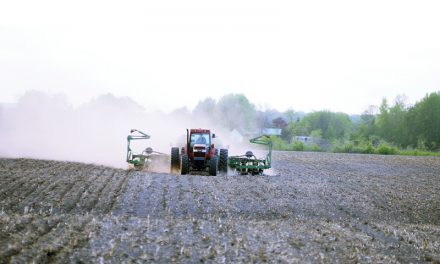MP Francis Drouin hosted an egg and poultry producer information session to discuss the USMCA. The meeting brought in representatives from Egg Farmers of Ontario and Chicken Farmers of Ontario. Sawyer Helmer photo
by Kalynn Sawyer Helmer
AgriNews Staff Writer
ST. ISIDORE – On Thurs., Nov. 8, Glengarry-Prescott-Russell MP Francis Drouin met with egg and poultry producers in St. Isidore to discuss the United States-Mexico-Canada Agreement (USMCA). Representatives from Chicken Farmers of Ontario (CFO) and Egg Farmers of Ontario (EFO) were present to give the audience updates on the provincial organizations’ stance on the current proceedings.
At the Nov. 8 meeting, Drouin told producers that the USMCA was still in negotiations for the final text and was not yet signed. Canada may be the last of the three countries to submit the final text as Drouin said it will need to be translated into both official languages. He added that there are also some juridical concerns between Canada and the U.S. with lawyers working on the deal now.
Despite the Nov. 30 deadline for the three countries to ratify the document, there is speculation that the recent midterm elections in the U.S. and the change of power in the House of Representative to a Democratic majority could postpone any official signing until a later date. Drouin said the Democratic Party in the U.S. has not indicated if they are leaning for or against the deal, so nothing could be confirmed.
If the agreement is respected and approved by Canada and the U.S. congress, Drouin said Canada will have to submit the final text to parliament within a 21 day period. “If it’s not happening before Dec. 14, it will go until Jan. 27 and 28,” explained Drouin. The standard process involves a first, second and third reading followed by the same process in the Senate. Once passed there is a 60 day period to put the agreement into place. “In the case of best scenario, the agreement will be effective sometime in September or October 2019,” Drouin told the crowd.
Chris Horbász, CFO director, corporate and regulatory affairs, was first up to speak to the gathered producers. His presentation mirrored the district meeting held only a week before but added a few insights to the organization’s efforts with the USMCA.
“In terms of the Chicken Farmers of Ontario, our vision speaks to a growing profitable and sustainable chicken industry. We’ve been very fortunate in the chicken industry, we’ve had a very strong sector and the future is also very bright. Ultimately addressing trade agreements, contributes to achieving this vision,” said Horbász.
The chicken industry is profitable and continues to grow while the CFO looks to improve quality even further and lower risk. Horbász said the CFO sees trade as a second priority to consider in the industry. “It’s about the economic risk that agreements bring, it’s about the rules around access and control.”
Horbász reminded the producers of the last two governments, the first Conservative with Prime Minister Harper and now Liberal with Prime Minister Trudeau. During both governments, Canada has pursued and increased trade.
Now with both the comprehensive and progressive trans pacific partnership (CPTPP) and the USMCA, the way imports occur and access to the market has changed. Horbász said the issue was of great importance, especially because of the increased access for both agreements which are multi-year programs. The most significant of which will be within the first six years, with a 10 million kilogram increase and will then drastically slow in growth for the remaining years.
Horbász displayed a chart outlining the access for chicken farmers which will grow from 7.6 per cent in 2017 to 10.8 per cent in 2037. “Specifically to the USMCA, it will grow to 63 million kilograms and so overall when you look at all the agreements, there will be an increase of 12.7 million kilograms over 16 years,” Horbász said.
These numbers are in addition to the CPTPP that provides access to 26.7 million kilograms over 20 years.
While Horbász said the CFO will monitor the process closely, they are also working with the government to ensure the voices of their producers are heard. “It would be our position that the federal government must be accountable and execute on their commitments to better control imports at the border and certainly deal with mitigating the impact of the USMCA as well as the CPTPP. Certainly Chicken Farmers of Ontario as well as Chicken Farmers of Canada are very active in this regard and will continue to do so in the short-term,” he said.
Next up to speak to the producers in the room was Scott Graham, chair and Zone 6 director for EFO.
Graham began by sharing some good news from meetings earlier in November that EFC aims to put 1.4 million addition birds out across the country, pending approval from Farm Products Council of Canada (FPCC). News of approval will be available by the beginning of the year and would come into effect six months thereafter.
“It’s an agreement with our hatchers, so based on the MGA, the market growth allowance of 92,000 at the first of the year, we applied for some more EFP birds, 67,000. Our share of the 1.4 million is about 94,000 birds, so in total about 650,000 birds to distribute across Ontario to our producers,” said Graham. “A portion of that will be per quota and the balance per rata across the whole industry so, as much as we were affected by the access through the trade negotiations and the increased access to our market, we’re much like the chicken business in that we are fortunate to be in a growth mode in our business.”
That growth equals close to 40 per cent more consumption over the last 12 years.
As for the USMCA, Graham said that EFO are concerned – which is normal whenever new access is granted.
“Our system is based on domestic supply and it was a little disheartening especially in terms of the demand by U.S. producers that was basically that they wanted to just maintain their access to our market,” he said.
Graham and his colleagues had attended United Egg Producer (UEP) meetings and found no indication that the producers were looking for additional access.
Basing the numbers on a figure of 10 million birds, Graham said that in six years the access increases from 1.6 million dozen up to 10 million dozen. By the end of 16 years, the numbers are around 11.5 million dozen.
“11.5 million dozen equates to over 400,000 birds that aren’t raised here, aren’t fed here, that don’t produce eggs here and that aren’t graded or processed here in Ontario,” Graham said.
While he said there is mutual respect on both sides of the border for the way the other produces eggs, Graham is proud of the Canadian process. Across the country, Canada has about 1,100 egg producers; the majority are family owned farms. On the other side of the border, there are roughly 40 to 50 corporate families that monopolize the egg business.
This means that the access granted, causes major losses in Canada. For Canadian eggs, all production is graded and processed on home soil. “It has a huge economic impact. Just on what we lost, or what we have in trade equates to probably $25 to $30-million in loss. And that was just in I think feed alone. That is only our industry, not chicken or turkey or hatching eggs. So it has a huge impact and there are a lot of people who are really concerned about it,” said Graham.
While the government has promised compensation, Graham said the producers aren’t looking for any. “One of the things that we continue to stress with the government is the importance of this type of marketing system to our rural communities, to the quality of food that we produce, the safety of the food and the economic impact this industry has on our rural communities.”
With the EFO keeping an eye on the deal there is one aspect that Graham said is causing more concern than others. The new access suggests that 30 per cent of the numbers – which equals roughly three million dozen eggs – is allocated to ‘new entrance’.
Graham continued to explain: “We’re a little concerned that it might be quota or access to TRQ allotment to retailers for instance that could bring things in from the U.S. If they are sourcing those things on their own, they might be able to get eggs, especially in certain market conditions, that are fairly low-priced and have a real market advantage against some of the other retailers.”
He added that CFO would prefer to have producers who already have permits be allocated that access. Overall however, Graham said CFO is looking forward to future growth and is optimistic.
News in early December will give some insight into the future of the deal. Once ratified these organizations will be able to give their producers a better understand of all the USMCA entails. Due to AgriNews’ print schedule, check the website at www.agrinews.ca for updates on the trade negotiations.













